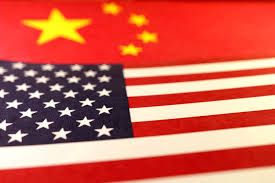Its relative economic strength and versatility pose formidable challenges to reducing interdependence.
The heavily inward-looking stance of the U.S. administration under President Trump has perceptibly heated up its rivalry with China, besides agitating its own long-time allies around the world. In pursuing an almost 360-degree Make America Great Again (MAGA) campaign, the U.S. has started going after the countries it perceives as possible threats, beginning with those with which it has a trade deficit.
Apart from Iran—which for years had been doggedly pursuing its ambition to develop a nuclear weapon—China was at the top of the list of the fifty-odd nations the US has proceeded against. The impulsive snap actions initiated against China, and the continued threats being held out, are laden with tremendous uncertainty and high risks. Several of these not-so-well-thought-out measures have a distinct potential to step up the social, political, and fiscal fragilities in the impacted geographies—as well as in the initiator, the U.S. itself.
With the ongoing trade war launched in April 2025—consisting of multiple high tariffs on imports into the U.S., coupled with a host of non-tariff barriers—the latest World Bank Global Economic Prospects assesses that global growth might markedly slow to 2.3% in 2025, 0.4 percentage points below its January 2025 forecast. Excluding the full-fledged recessions of 2009 and 2020, this would mark the slowest pace of global growth since 2008. In 2026-27, the Bank estimates that growth might lift to a subdued 2.5%, still far below the pre-pandemic decadal average of 3.1%. It is worth highlighting that the pace in developing countries has been ratcheting downward now for three consecutive decades—from an average of 5.9% in the 2010s, to 3.7% in the early 2020s and a discouraging 2.3% this year. The Bank apprehends that “with the exception of China, it might take two decades for these countries to recoup their losses of the 2020s.”
The OECD—the 38-nation grouping of mostly developed countries—which met on June 3 at its headquarters in Paris, reiterated that trade, consumption, and investment have been affected by the ongoing tariff war with China, and warned that the U.S. economy could suffer the most. It further cautioned that this conflict would adversely impact several other economies in its orbit, such as Mexico. The densely populated country, still classified as a developing nation, is highly vulnerable to the tariff war and the deteriorating bilateral relations between the U.S. and China. Eighty per cent of its exports, including many goods produced by Chinese firms that have quickly relocated there, go to the U.S., its main trading partner.
The emerging economic woes, such as a recession amid rising prices and a scarcity of various goods and services, are becoming both a cause and an effect of the ongoing geopolitical developments and the “America First” policy. The global trade growth has been on the decline for some time now: from 5.9% in the 2000s to 5.1% in the 2010s, and a meager 3.7% in the 2020s. Meanwhile, global debt has continued to accumulate. The Chinese entities which own a significantly large volume of the US Treasury bonds, through their concerted actions, can cause undesirable movements in its bond market.
Together, these factors have contributed to a 7% decline in the value of the U.S. dollar, though it remains the dominant reserve currency in the world. Gold has now surpassed the Euro as the second most valuable reserve asset. Another serious consequence has been the reluctance of industrialized nations—led by the U.S.—to adequately invest in addressing and mitigating the multiple factors driving ongoing climate change, potentially paving the way for an environmental disaster in the not-too-distant future.
THE WORLD’S DEPENDENCE UPON CHINA
With the world currently facing more violent conflicts than at any time in the eight decades since the end of the Second World War, no one can realistically predict when the bilateral tit-for-tat escalations will slow down—let alone come to a complete halt. These assaults and retaliations are taking place despite the significant mutual economic interdependence between the U.S. and China—and, in fact, the rest of the world’s dependence on them as well. Together, the GDP of these two rival giants stands at a staggering US$46 trillion, or nearly 45% of the global total. Given their differing but complementary comparative advantages, this mutual dependence cannot easily be wished away.
On the other hand, since the early 1980s, China has systematically and strategically built its economy, leading to a significant reliance on it by most nations—both developed and developing. About 37% of China’s large GDP is accounted for by external trade. Its output—both merchandise and services—is competitively priced, and over time, quality and standardization have concurrently improved. By consistently scaling up production volumes, China has reaped substantial economies of scale. This advantage stems from cost-effective procurement of raw materials, efficient processing of goods, and strong capabilities in securing and executing export orders.
Of high relevance in recent years is the integration of modern technology into Chinese manufacturing, including in traditionally labour-intensive industries. With manpower availability affected by nearly two generations of the one-child policy, and wages sharply increasing, automation is being explored across the board. In certain industries such as smartphone and automobile assembly, appliance manufacturing, semiconductors, and even construction materials, advanced machinery, AI systems, and robotics are being deployed. This transformation is being pursued across all stages of production—assembly, inspection, and logistics—freeing human labour for operations less amenable to high automation. Such automation eliminates human error, reduces labour costs, and allows for continuous operation without breaks or fatigue. The new systems also detect anomalies before they escalate into problems, while minor defects, sensor issues, and operational glitches are corrected autonomously without human intervention.
The International Federation of Robotics estimated that, in 2023, China deployed 290,000 industrial robots, accounting for 52% of global robotics installations. That China has effectively cracked the code for scalable, AI-driven manufacturing is becoming increasingly evident. Xiaomi, the smartphone manufacturer, exemplifies this data driven transformation. By leveraging its inhouse Hyper Intelligent Manufacturing Platform(Hyper IMP), an AI-powered ecosystem where machines don’t just follow orders but think, adapt and optimize, its automated mass production factory on the outskirts of Beijing, produces one smartphone every few seconds, exceeding 10 million units annually. With no humans on the shop floor and highly reduced need for human-centric infrastructure of lighting, heating and break areas ultimately causing lower energy consumption, such “dark factories” have become centres of efficient production.
Statista estimates that the Manufacturing Labour Cost in China in 2023 was USD 5.51/hour while the Cost of Running an Industrial Robot in China was USD1.6, and USD2.0 /hour after amortization and maintenance. It makes a case for using robots in preference to humans. That was the outcome of the Chinese R&D annual-spend of $600 bn in 2024 which exceeded USA’s. Its firms had filed 1.7 million patents—the highest in the world, as per the World Intellectual Property Organization (WIPO).
China’s own large and expanding market—home to 1.4 billion people and supported by a skilled workforce with a per capita income of $12,600 at constant prices (and over $22,000 in PPP terms)—absorbs huge volumes of raw materials and finished products sourced from all parts of the globe. The recent economic slowdown, triggered by the bursting of the property boom and a nearly 80% decline in real estate demand, has contributed to a global drop in the prices of several primary products, particularly those coming from countries in Africa, South America, and Asia. China’s favourable endowment of natural resources has also granted it a dominant position in several key minerals, giving the country a strategic edge.
China has about one half of the global reserves of rare earths—the group of 17 minerals with applications ranging from electronics to renewable energy systems. Its share, including the absolute amount of reserves, has not changed much over the last three decades, while the US reserves have declined substantially. Brazil has now taken its second position. Besides the reserves, China also produces two-thirds of the actual output and its share in global processing and refining is almost 90%. The April 6, 2025, Chinese regulation requiring special licenses for the export of 7 rare earth elements had set off alarm bells in the U.S. and elsewhere. Processed minerals essential for manufacturing advanced industrial magnets—particularly those made using the less abundant and mined selenium, dysprosium, and terbium—are currently produced almost exclusively in China. These high-performance magnets can withstand intense temperatures and are needed in the production of sophisticated armaments such as missiles, spacecrafts, wind turbines and electric vehicles.
The U.S.’s considerable apprehensions about these new barriers had led President Trump to call President Xi in late May and propose a truce in the trade war. Reportedly, he also agreed to lift the restrictions on the issuance of visas to the thousands of Chinese students who come each year to study at American universities. A similar easing of limitations on the export of U.S. technology, crucial for designing and manufacturing high-quality microchips, was also assured.
For over a generation now, American consumers have been living on cheap imports from neighbouring countries such as Canada, Mexico, and Latin American nations like Colombia, Honduras, and the Dominican Republic, as well as more distant sources like China, South Korea, and Vietnam. The U.S. production of most everyday goods, and intermediate products used in further processing or conversion, has been significantly outsourced to these nations. Over time, these regions have developed even greater comparative advantages relative to the U.S., initially due to lower labour costs and increasingly through more efficient use of other factors of production. Combined, these trends are turning into higher overall factor productivity and further perpetuating the dependence.
The Americans, instead of endeavouring to compete in manufacturing are increasingly gravitating toward the tertiary sector. These service-based activities, no doubt, support the secondary sector and facilitate the development of a wide range of new technologies across nearly all areas of economic activity—including the conception of new products. Globally, most white-collar jobs in such vocations tend to offer better pay than roles in the primary or manufacturing sectors. Being “cleaner” and often “movable”—either to another location or suitable for remote work—these jobs have become the preferred option for many. With services dominating its national GDP, the U.S. also boasts a high daily labour productivity in value terms, estimated at $97, compared to $9.5 in China and $5.4 in India.
* Dr Ajay Dua, a development economist, is a former Union Secretary, Commerce & Industry.
Part II will examine the economic interdependence between China and India.







